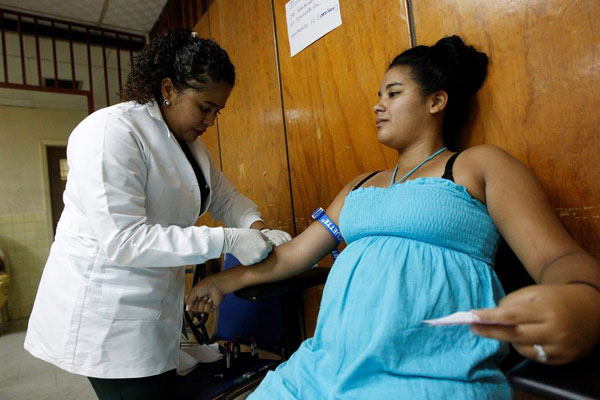500 million people at risk of contracting Zika in Americas: PAHO official
Updated: 2016-05-04 10:00
(Xinhua)
|
||||||||
 |
|
A nurse extracts blood from a pregnant woman as part of a general routine check, which includes examination for mosquito-borne viruses like Zika, at the maternity ward of the Hospital Escuela in Tegucigalpa, Honduras, April 15, 2016. [Photo/Agencies] |
WASHINGTON - About 500 million people in the Americas are at risk of being infected by the Zika virus, which can cause birth defects such as microcephaly, a senior official from the Pan American Health Organization (PAHO) said Tuesday.
"It's important to note that all countries which have reported, detected Dengue and Chikungunya virus outbreaks during the last years, that's 15 years, are considered at risk for having outbreaks of Zika," Sylvain Aldighieri, Zika incident manager for PAHO, told reporters here.
"It means that we are expecting outbreaks of Zika from Middle America to Latin America to the north of Argentina and in the Caribbean. So it's a very large portion of territory of the region."
Aldighieri said so far the number of countries and territories in the Americas reporting Zika virus transmission has increased to 37, of which five countries including Brazil have reported microcephaly.
Anthony Fauci, director of the US National Institute of Allergy and Infectious Diseases, told reporters at the briefing that his agency is working to begin a clinical trial for a Zika vaccine in September.
"We will probably know if it's safe by the beginning of 2017," said Fauci. "And if it is, we'll engage in a very large efficacy study likely in South America or in the Caribbean and that should take anywhere from one to three years to prove that it works or does not work."
Zika is transmitted primarily through the bite of an infected Aedes species mosquito, which also spreads chikungunya and dengue.
Symptoms include fever, rash, joint pain and red eyes, but severe disease requiring hospitalization is uncommon and case fatality is low. There is no vaccine or medicine available for the virus.
- Number of Zika cases in Brazil drops: WHO
- Chinese scientists figure out Zika virus NS1 protein structure
- Zika confirmed as cause of birth defects
- US health authorities confirm Zika causes microcephaly
- Confirmation that Zika causes microcephaly shifts debate to prevention
- South China province reports 11th Zika case
- Massive protests against Abe mark Japan's Constitution Memorial Day
- Go kitesurfing in Israel
- 500 million people at risk of contracting Zika in Americas: PAHO official
- UN urges DPRK to stop 'further provocative action'
- China stresses Putin's expected visit
- British FM visits Cuba for 1st time since 1959

 Olympic flame lands in Brazil for 94-day relay to Games
Olympic flame lands in Brazil for 94-day relay to Games
 Top 10 least affordable cities to rent in
Top 10 least affordable cities to rent in
 Exhibition of Tibetan Thangka painting held in Lhasa
Exhibition of Tibetan Thangka painting held in Lhasa
 Storm's aftermath is a pink petal paradise
Storm's aftermath is a pink petal paradise
 Xinjiang-Tibet Highway: Top of the world
Xinjiang-Tibet Highway: Top of the world
 Female patrol team seen at West Lake in Hangzhou
Female patrol team seen at West Lake in Hangzhou
 Drones monitoring traffic during May Day holiday
Drones monitoring traffic during May Day holiday
 Sino-Italian police patrols launched in Italy
Sino-Italian police patrols launched in Italy
Most Viewed
Editor's Picks

|

|

|

|

|

|
Today's Top News
Liang avoids jail in shooting death
China's finance minister addresses ratings downgrade
Duke alumni visit Chinese Embassy
Marriott unlikely to top Anbang offer for Starwood: Observers
Chinese biopharma debuts on Nasdaq
What ends Jeb Bush's White House hopes
Investigation for Nicolas's campaign
Will US-ASEAN meeting be good for region?
US Weekly

|

|









